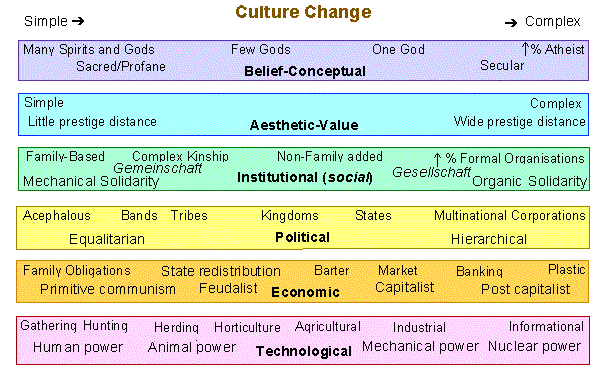Translations:
'العربية / al-ʿarabīyah
Català
Ελληνικά
Española
Filipino
Français
Italiano
بهاس ملايو / Bahasa Melayu
Portuguesa
Română
Pycкий
Srpski
ไทย / Thai
Tiên Việt
中文 / Zhōngwén
Other Pages:
Key Words
Modules
Sociology:
Home Page
Lecture Notes
Discussions
Hub
Utilities:
Site Map
Contact
Utility Documents
Useful Links
THE MEANING of CULTURE
by Phil Bartle, PhD
Training Handout
The simplest definition of culture is that it is composed of everything symbolic that we learn.
All culture is learned, but not everything learned is culture.
It includes all our actions and beliefs that are not transmitted by genes, but are transmitted (and stored) by symbols.
Symbols are meaningless in themselves (intrinsically) unless they are given meaning by humans.
Our values include whatever we think of as good versus bad, right versus wrong or beautiful versus ugly.
They belong to one of the six dimensions of culture.
Different communities or societies have different sets of values.
Where they differ there is a potential for conflict of values.
Similarly, different communities may have different economic systems (another of the six dimensions).
For thousands of years we have had the Cain-Abel conflict between horticultural (planting) societies and nomadicherders.
They use land in contradictory ways, incompatible with each other.
Horticulturalists need to fence off their land to protect their vegetables, while herders need to have unfenced spaces where their cattle can roam to eat.
(Cain was a tiller while Abel was a herder, and their story may be an ancient symbolic representation of that incompatibility).
We can find examples for all six cultural dimensions have incompatible ways of operating, and those may be the basis for cultural conflict, where two or more communities differ and try to occupy the same space or territory.
In a community, which has a set of variables in all six dimensions, there may exist a sub set of that community with variances from the larger community.
That would be a sub culture. Usually the notion implies a sub set of values or beliefs, while the variances of the sub set (sub culture) could be in any of the six cultural dimensions.
The word “hegemony” usually applies to political hegemony, where there is a dominant community or society, and also a nearby weaker community which tends to be informally dominated politically by the stronger neighbour.
Politics is only one of the six cultural dimensions, however, and that influence or informal domination may apply to any of those dimensions.
It is unlikely that they would apply to only one.
While Canadians do try to see themselves as a country independent of the USA, trade relations make the USA have informal domination over Canada’s economy.
The production of popular literature, music, cinema, television, and radio entertainment in the USA, which have much bigger and stronger markets than in Canada, means there is cultural hegemony (in terms of aesthetics in the value dimension) of the USA over Canada.
There are similar relations of hegemony on all the continents, but we in Canada are most conscious of the USA.
──»«──
Cultural Dimensions:

|